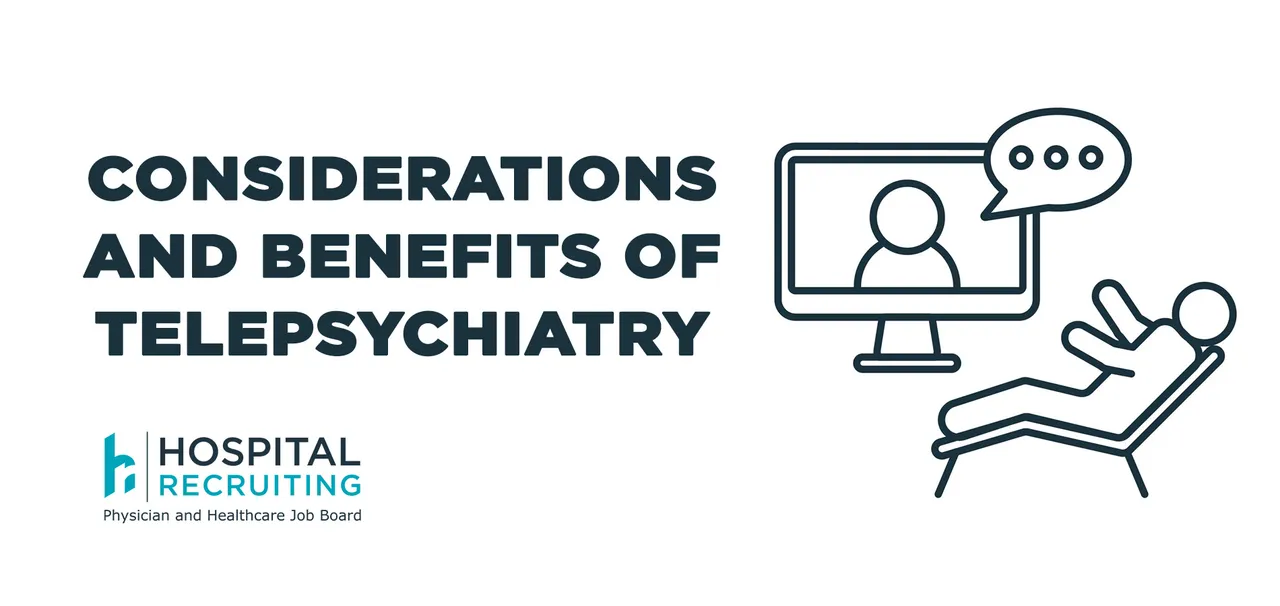Benefits and Important Considerations of Telepsychiatry

Virtual healthcare, also known as telehealth, allows a patient to meet with their provider for an appointment anywhere outside of the traditional office. Easily accessible through the internet, you can schedule and attend an appointment on your smartphone, tablet or laptop. Patients are able to complete their appointments privately and comfortably from their own environment. However, telemedicine has its limitations, specifically when a physical assessment is required.
Telepsychiatry, on the other hand, can be completed entirely virtually. In psychiatry, the mental status exam is completed from one-on-one interaction with a patient. Examination and treatment planning occurs from the interaction between the client and the provider, which telehealth provides with ease. Virtual healthcare has been able to grow with various providers; psychiatrists, therapists, couples therapists, psychologists, nurse practitioners, social workers, and many others.
Here are a few of the important considerations and benefits of practicing psychiatry virtually.
Easily Accessible Care
Telepsychiatry has eliminated the in-office waiting period and expanded into wider access, eliminating physical boundaries between patients and their providers. The COVID-19 emergency status allowed patients to seek care from providers outside of their local community, with many opting for telehealth solutions. The virtual connectivity provided increased communication between providers, as well as providing care to those with limited options.
Privacy in Psychiatry
Psychiatric and mental health practice largely remains the same, regardless of virtual or in-office locations. Patient privacy is of utmost importance, requiring all electronic health records to be HIPAA compliant. Many EHR systems have expanded their technology to include video and audio capabilities that are in compliance for patient privacy.
Insurance Coverage
A majority of insurance carriers continue to cover telehealth appointments, despite the public emergency ending. Coverage is delineated by each insurance plan. Patients can access this information when reviewing benefits, or by reaching out to their insurance company. Copays and deductibles for telehealth visits are included in insurance benefits.
Each private insurance company has plans that vary state to state. You submit all of the out-of-state insurance carriers to your current state carrier. For example, you are in Colorado and your patient has Blue Cross Blue Shield of Oregon. This is submitted to Blue Cross Blue Shield of Colorado. Reimbursement rates will also follow your state carrier and fee schedule.
Provider contracts for reimbursement are also limited to states, and these are not carried over for claims. For the above example, you will not receive the Oregon BCBS reimbursement rate, but you will receive Colorado reimbursement rate, even if they differ significantly.
Provider Billing
The Centers for Medicaid and Medicare dictate our billing and coding. Telepsychiatry is typically billed as a standard E/M code CPT, this may nor may not have a modifier on it distinguishing in office or virtual. CMS provides guidance on appropriate CPT codes, modifiers and exceptions for all virtual appointments. You can access these online, as well as reimbursement rates at the CMS homepage. Typically, private insurance companies follow the standard set by CMS, but each carrier may require different modifiers for CPT codes. These are all accessible in the billing information provided from each insurance carrier. They also provide reimbursement rates for each code and among various provider types.
Licensing
Licenses are managed by the state and provide delineated requirements for each provider type, which can limit a provider to only provide care in said state. Every state has these accessible on their state health page. Thanks to telehealth, some of these state lines or physical boundaries are eliminated when receiving virtual care. However, it is important the provider is aware of licensing requirements for the state they practice in and the state they are providing services. Prescribing medications across state lines can be problematic. Depending on the state, prescriptions may not be filled if the rendering provider does not follow their state guidelines.
For example, Texas requires all nurse practitioners to have a supervising MD/DO in order to practice. Other states have eliminated this and granted nurse practitioners independent practice. You may practice in an independent practice state, though if delivery of care is in a state that does not allow this, it can be difficult for patients to physically obtain treatments. Pharmacists, as providers, have their own standards of care, and can decline to fill medications if the prescriber does not meet their state requirements.
Additional resources accessible online:
AMA Telehealth Quick Guide: https://www.ama-assn.org/practice-management/digital/ama-telehealth-quick-guide
APA Guidelines for telepsychiatry: https://www.apa.org/practice/guidelines/telepsychology
CMS Telehealth billing: https://www.cms.gov/medicare/coverage/telehealth
DEA Midlevels by state: https://www.deadiversion.usdoj.gov/drugreg/practioners/mlp_by_state.pdf
Related Posts
